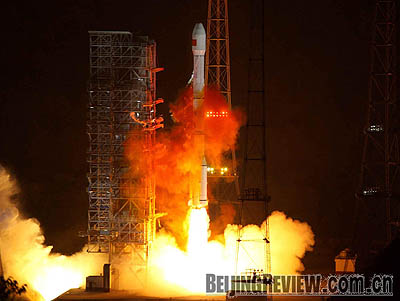|

LIFT OFF: China’s first data relay satellite, Tianlian 1, is launched on a Long March-3C carrier rocket from the Xichang Satellite Launch Center in southwest China’s Sichuan Province on April 25 ( Photo by LI GANG)
China established a space station to relay data from its space vehicles on May 1. The mission was accomplished by settling its first data relay satellite, Tianlian 1, at E.77 degrees over the equator.
The satellite blasted off on April 25 aboard a Long March-3C carrier rocket from the Xichang Satellite Launch Center in Sichuan Province. It has carried out a series of operations including unfolding its solar sail, igniting its engine and changing its positioning on four occasions.
The successful positioning has increased the coverage of the country's space measuring network, improved the country's capability of timely transmitting space data and reduced risks to future space missions. It also enhanced the efficiency of ground control and command, problem analysis and space rescue, according to an expert with Xi'an Satellite Monitor and Control Center.
The center will conduct comprehensive measuring on the satellite, which will be officially handed over to clients after it is confirmed to be operating in a normal and stable manner. But Tianlian 1 will not go into operation until the launch of China's Shenzhou 7 manned spacecraft, scheduled for the second half of 2008.
Data relay satellites are capable of providing data relay and monitoring and tracking services for other satellites and spaceships, thereby greatly improving the performance and crisis management capability of different types of satellites. They can also transmit data from land resources satellites and environmental satellites, thereby giving advance warning of major natural disasters.
Tianlian 1, developed by China Aerospace Science and Technology Corp., will increase the time Shenzhou 7 spaceship in communication with the ground, and improve the amount of data that can be transferred, according to Zhang Jianqi, an official with China's space program.
"The Yuanwang space tracking ships, along with China's more than 10 ground observation stations, can only cover 12 percent of Shenzhou 7 spaceship's orbit," Zhang said. Tianlian 1 satellite alone, according to Zhang, can cover 50 percent of the orbit of Shenzhou 7, or any other of China's spacecraft.
Scientists can collect more data without delay, and can identify earlier when a malfunction is taking place in a spacecraft with the help of the satellite.
Tianlian 1 was developed on China's most sophisticated Dongfanghong 3 telecommunications satellite platform and made multiple breakthroughs in key technologies. Its successful launch filled another gap in China's satellite science, industry experts say. As China's space program progresses, data relay satellites will be used more extensively.
The Long March-3C carrier rocket, which was used to send Tianlian 1 into space, is developed by the Chinese Academy of Carrier Rocket Technology under the China Aerospace Science and Technology Company Group. It is a 55-meter new-type third-class liquid propellant rocket clustered with two boosters. With a designed takeoff mass of approximately 343 tons, the rocket is capable of launching satellites weighing between 2.6 tons and 3.8 tons into space.
The latest launch is the 105th mission of Long March carrier rockets, but the inaugural one of Long March-3Cs.
Seven Long March-3C carrier rockets are currently in production and will carry "several domestic and foreign satellites" into space, according to China's space authorities.
Tianlian 1's blastoff was also China's first aerospace launch in 2008 and the first mission for the Yuanwang 5 space tracking ship, which was delivered last September to perform monitoring and tracking missions.
It was also the first time Xichang Satellite Launch Center's newly improved low-temperature fuel-filling provision and its No.2 Station for long-distance monitoring and tracking satellite launches were put into use. The successful launch proved the capability of a range of new equipment and showed the level to which China's overall aerospace capability has steadily improved. | 